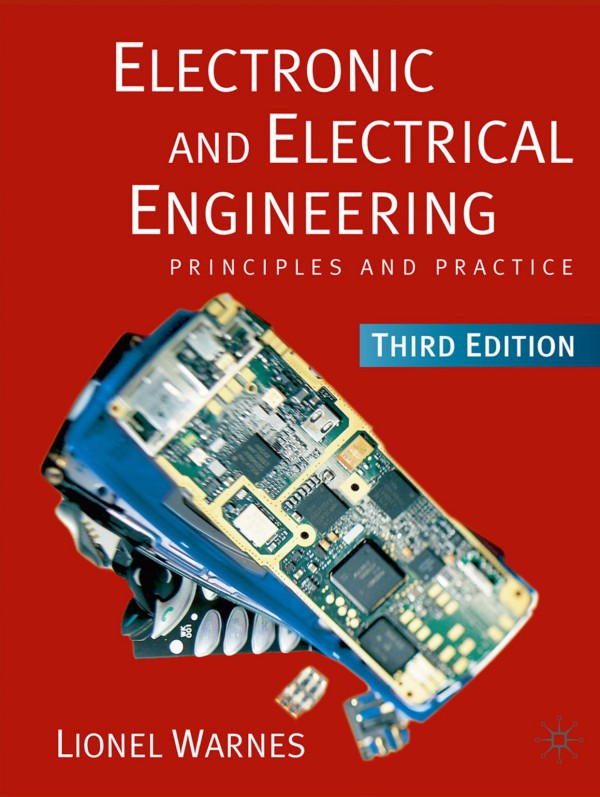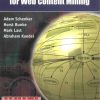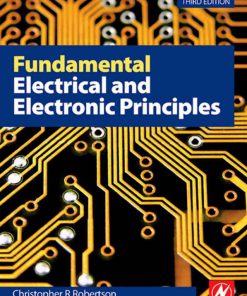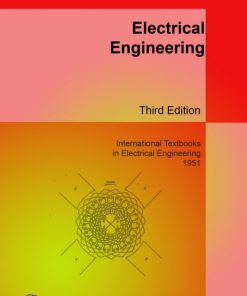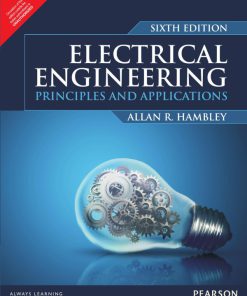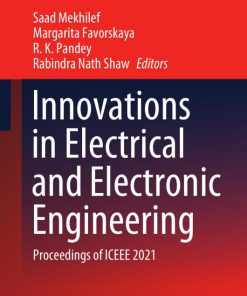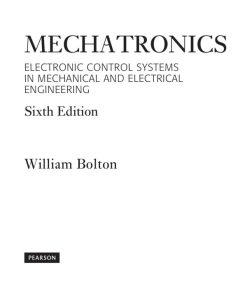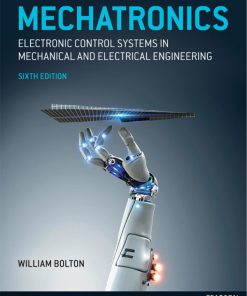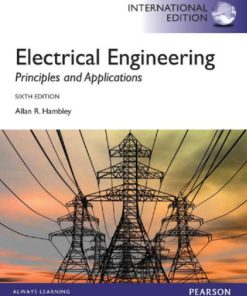(Ebook PDF) Electronic and Electrical Engineering Principles & Practice 3rd edition by Lionel Warnes 0230216331 9780230216334
$50.00 Original price was: $50.00.$25.00Current price is: $25.00.
Authors:Lionel Warnes , Series:Electrical Engineering [183] , Author sort:Warnes, Lionel , Languages:Languages:eng , Published:Published:Oct 2016 , Publisher:Palgrave Macmillan
Electronic & Electrical Engineering Principles & Practice 3rd edition by Lionel Warnes – Ebook PDF Instant Download/DeliveryISBN: 0230216331, 9780230216334
Full download Electronic & Electrical Engineering Principles & Practice 3rd edition after payment.
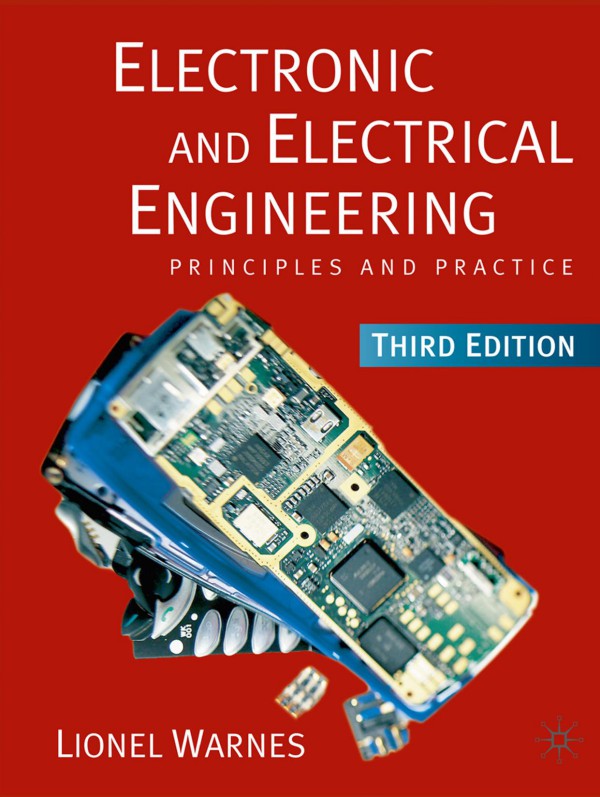
Product details:
ISBN-10 : 0230216331
ISBN-13 : 9780230216334
Author : Lionel Warnes
A third edition of this popular text which provides a foundation in electronic and electrical engineering for HND and undergraduate students. The book offers exceptional breadth of coverage without sacrificing depth. It uses a wealth of practical examples to illustrate the theory, and makes no excessive demands on the reader’s mathematical skills. Ideal as a teaching tool or for self-study.
Electronic & Electrical Engineering Principles & Practice 3rd Table of contents:
1 Circuit analysis
1.1 Sources
1.2 Passive circuit elements
1.3 Practical circuit elements
1.4 Circuit analysis and Kirchhoff’s laws
1.5 Circuit theorems and transformations
1.6 Power and energy
1.7 Mesh analysis and nodal analysis
Problems
2 Sinusoidally-excited circuits
2.1 Sinusoidal excitation
2.2 Phasors
2.3 Circuit analysis with AC
2.4 Power in AC circuits
2.5 Resonant circuits
Problems
3 Operational amplifiers
3.1 The golden rules
3.2 Some common op amp circuits
3.3 Analogue computing
3.4 Practical op amps
3.5 Comparators
3.6 Schmitt triggers
Problems
4 Transients
4.1 Transients in RC and RL circuits
4.2 Transient analysis by the Laplace transformation
4.3 Transients in RLC circuits
Problems
5 Bode diagrams and 2-port networks
5.1 The steady-state frequency response of circuits
5.2 Two-port networks
Problems
6 Semiconductors
6.1 Electrons and holes in semiconductors
6.2 Electrical conductivity
6.3 The p-n junction
6.4 A glossary of terms
Problems
7 Diodes
7.1 Junction diodes
7.2 Schottky diodes
7.3 Zener diodes
7.4 Light-emitting diodes (LEDs)
7.5 Solar cells
7.6 Applications for ordinary p-n junction diodes
Problems
8 Bipolar junction transistors
8.1 Theory of operation
8.2 The common-emitter amplifier
8.3 The emitter follower, or commoncollector amplifier
8.4 BJT switches
8.5 BJT specifications
Problems
9 Field-effect transistors
9.1 The junction field-effect transistor (JFET)
9.2 The practical common-source amplifier
9.3 MOSFETs
9.4 Specifications of some popular FETs
Problems
10 Integrated circuits
10.1 Integrated circuit fabrication
10.2 Hybrid circuits
Problems
11 Analogue circuits
11.1 Filters
11.2 Oscillators
11.3 Phase-locked loops
11.4 Waveform-generator ICs
11.5 Voltage regulators
11.6 Analogue-to-digital (A/D) and digital-to-analogue (D/A) converters
Problems
12 Power amplifiers, power supplies and batteries
12.1 Class-A amplifiers
12.2 Class-B amplifiers
12.3 Class-C amplifiers
12.4 Class-D amplifiers
12.5 Power supplies
12.6 Switch-mode power supplies
12.7 Batteries
12.8 Cooling
Problems
13 Magnetism and electromagnetism
13.1 Magnetic units and quantities
13.2 The magnetic circuit
13.3 Faraday’s law of electromagnetic induction
13.4 Hysteresis
13.5 Eddy currents
13.6 Inductors
Problems
14 DC machines
14.1 A prototype generator
14.2 DC generators
14.3 DC motors
14.4 Efficiency and losses
Problems
15 Three-phase systems
15.1 The generation of three-phase electricity
15.2 Balanced loads
15.3 Unbalanced loads
15.4 Power measurement in threephase circuits
Problems
16 Transformers
16.1 The ideal transformer
16.2 Transformer testing
16.3 Practical transformers
16.4 Transformer design
16.5 Special types of transformer
Problems
17 Induction motors
17.1 Construction of a squirrel-cage motor
17.2 The rotation of the stator field
17.3 Slip
17.4 The equivalent circuit of an induction machine
17.5 Torque and slip in an induction machine
17.6 Evaluating the components of the equivalent circuit
17.7 Power and efficiency
17.8 Practical induction machines
17.9 Domestic-supply induction motors
Problems
18 Synchronous machines
18.1 Synchronous generators
18.2 Synchronous torque
18.3 The equivalent circuit of a synchronous generator
18.4 Per-unit values and the shortcircuit ratio
18.5 The generator under load
18.6 The generator on an infinite bus
18.7 The construction of synchronous machines
18.8 Synchronous motors
Problems
19 Power electronics
19.1 The three-phase bridge rectifier
19.2 Power semiconductor devices
19.3 Power-control circuits using thyristors
19.4 Motor control with power electronics
Problems
20 Combinational logic
20.1 Binary and hexadecimal numbers
20.2 Logic functions and Boolean algebra
20.3 Logic ICs
20.4 De Morgan’s theorems
20.5 Minterms and maxterms
20.6 Karnaugh mapping and circuit minimisation
20.7 Practical examples
20.8 Logic families
20.9 Practical aspects of logic integrated circuits
20.10 Multiplexers and demultiplexers
20.11 Programmable logic arrays
Problems
21 Sequential logic
21.1 Unclocked flip-flops
21.2 Clocked flip-flops
21.3 Counters and shift registers
21.4 The monostable multivibrator
21.5 Timers
Problems
22 Computers
22.1 Computer architecture
22.2 The CPU
22.3 Memory
22.4 Input and output devices
22.5 Computer networks
22.6 Programming languages
23 Microprocessors and microcontrollers
23.1 The 8051 microcontrollers
23.2 The 8051 clock and the machine cycle time
23.3 The special-function registers (SFRs)
23.4 Moving data
23.5 Logical operations
23.6 Arithmetic operations
23.7 Jumps
23.8 Calls and subroutines
23.9 Look-up tables
23.10 Interfacing
24 Analogue communications
24.1 The elements of a communications system
24.2 The electromagnetic spectrum
24.3 Amplitude modulation
24.4 Frequency modulation
24.5 AM and FM compared
24.6 Pulse modulation
24.7 Noise
Problems
25 Digital communications
25.1 Binary modulation
25.2 Pulse-code modulation
25.3 The theoretical maximum channel capacity
Problems
26 Fibre-optic communications
26.1 Pros and cons of fibre-optics
26.2 The transmitter
26.3 The channel: optical fibres
26.4 Optoelectronic signal detectors
26.5 The ultimate performance of optical receivers
Problems
27 Telephony
27.1 Signalling
27.2 Transmission systems
27.3 Multiplexing
27.4 Companding
27.5 Telephone exchanges
27.6 Telephone-traffic theory
27.7 SPC exchanges
27.8 The integrated-services digital network (ISDN)
27.9 Mobile telephony
Problems
28 Electromagnetic compatibility
28.1 Sources of electromagnetic interference
28.2 Conductor shielding
28.3 Grounding
28.4 Shielding with sheet conductors
28.5 EMI filtering
28.6 Legal requirements for EMC
Problems
29 Measurements and instruments instruments
29.1 Accuracy
29.2 Standards and transducers for measurements
29.3 Instruments
People also search forElectronic & Electrical Engineering Principles & Practice 3rd:
electrical and electronic engineering principles
electronic and electrical engineering principles and practice pdf
electronic and electrical engineering principles and practice
synopsis of electrical and electronic engineering principles
elements of electrical and electronics engineering

